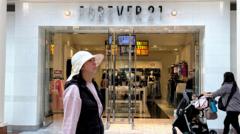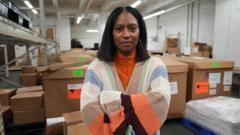As live shopping gains traction in markets outside Asia, its sustainability and appeal among Western audiences remain in debate.
Live Shopping: The Future of Retail or a Passing Trend?

Live Shopping: The Future of Retail or a Passing Trend?
A deeper look into the rising phenomenon of live shopping and its potential impact on consumer behavior.
Live shopping is redefining retail experiences, blending entertainment and e-commerce. Cleveland's Kelsey Krakora transitioned from the restaurant industry into this virtual selling space, finding remarkable success. Her live shows on platforms such as Poshmark have become lucrative, averaging about $1,000 in sales per session. With engaging formats allowing viewers to shop from the comfort of their homes, live shopping mirrors traditional TV shopping channels while adapting to the digital era.
Asia has long been at the forefront of live shopping, with platforms like Douyin driving this trend forward. However, as U.S. and European brands explore this avenue, it's essential to consider the preferences of these consumers, many of whom prefer hands-on shopping. A reported $32 billion market indicates significant interest, particularly in sectors like fashion and cosmetics. A substantial number of U.S. consumers are engaging with live shopping—45% have participated in the last year alone.
But experts remain cautious. Analysts point out that what works in China may not translate seamlessly to Western markets. Cultural differences, such as reliance on established Key Opinion Leaders (KOLs) and a different retail landscape, bring skepticism about live shopping's scalability. Moreover, shoppers like Krakora acknowledge that not every product suits the live format; items requiring a personal fit often still benefit from in-store experiences.
Despite concerns, brands are eager to leverage this new sales method. Industry giants such as Nordstrom and L'Oreal are diving into live shopping, hoping the interactive nature will enhance customer engagement. Poshmark’s CEO, Manish Chandra, emphasizes the community connection fostered during these events, marking a shift in shopping experiences.
Some retailers have observed impressive results. The House of Amouage, for example, saw significant sales in China through live streaming and is now tapping into U.S. markets thanks to the connections made through this format. Their rapid feedback loop enables them to align with customer desires more accurately than traditional surveys.
As live shopping continues to evolve, its long-term viability remains unclear. While it presents new opportunities for brands, the challenge lies in convincing Western consumers of its worth as they adapt to this novel way of purchasing. The debate on live shopping as a temporary trend or a transformative retail model is ongoing, leaving industry watchers eager for the next developments.
Asia has long been at the forefront of live shopping, with platforms like Douyin driving this trend forward. However, as U.S. and European brands explore this avenue, it's essential to consider the preferences of these consumers, many of whom prefer hands-on shopping. A reported $32 billion market indicates significant interest, particularly in sectors like fashion and cosmetics. A substantial number of U.S. consumers are engaging with live shopping—45% have participated in the last year alone.
But experts remain cautious. Analysts point out that what works in China may not translate seamlessly to Western markets. Cultural differences, such as reliance on established Key Opinion Leaders (KOLs) and a different retail landscape, bring skepticism about live shopping's scalability. Moreover, shoppers like Krakora acknowledge that not every product suits the live format; items requiring a personal fit often still benefit from in-store experiences.
Despite concerns, brands are eager to leverage this new sales method. Industry giants such as Nordstrom and L'Oreal are diving into live shopping, hoping the interactive nature will enhance customer engagement. Poshmark’s CEO, Manish Chandra, emphasizes the community connection fostered during these events, marking a shift in shopping experiences.
Some retailers have observed impressive results. The House of Amouage, for example, saw significant sales in China through live streaming and is now tapping into U.S. markets thanks to the connections made through this format. Their rapid feedback loop enables them to align with customer desires more accurately than traditional surveys.
As live shopping continues to evolve, its long-term viability remains unclear. While it presents new opportunities for brands, the challenge lies in convincing Western consumers of its worth as they adapt to this novel way of purchasing. The debate on live shopping as a temporary trend or a transformative retail model is ongoing, leaving industry watchers eager for the next developments.
















